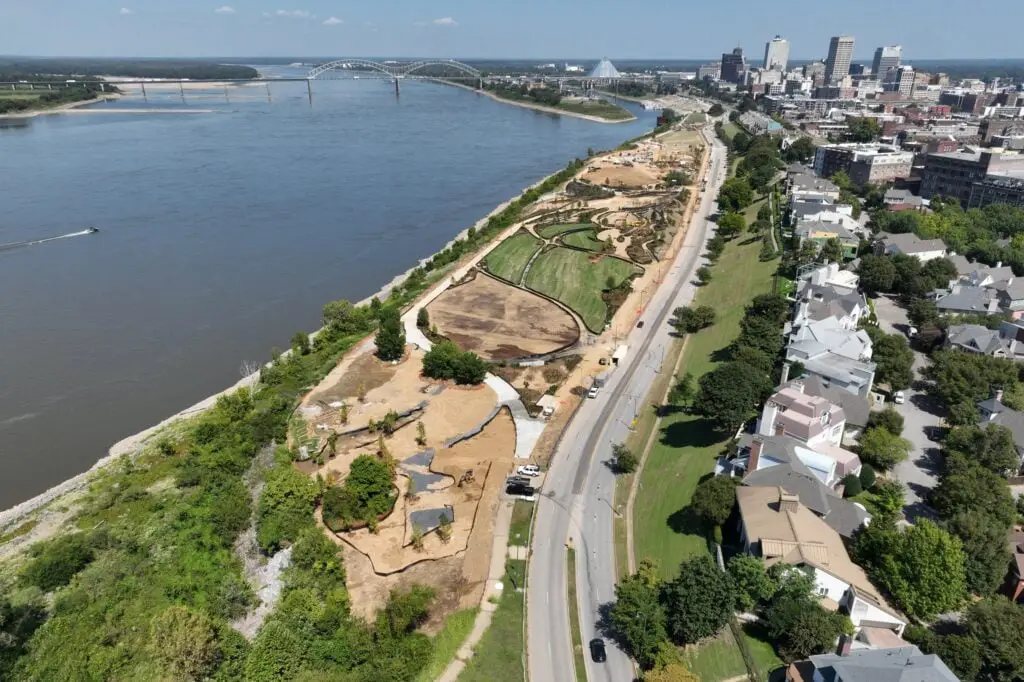Nestled along the iconic Mississippi River, the Memphis Riverfront stands as a vibrant testament to the city’s rich history and cultural dynamism. Beyond the immediate allure of the river’s flowing waters and the bustling activities along its banks, the riverfront serves as a gateway to a tapestry of nearby attractions that collectively contribute to the diverse and captivating essence of Memphis. This urban gem not only encapsulates the spirit of the city but also extends its reach into an array of historical, artistic, and entertainment hubs, inviting locals and visitors to embark on an enriching journey through the soul of Memphis.
The Memphis Riverfront is more than a picturesque landscape; it’s a living canvas that encapsulates the city’s evolution. As you explore the banks of the mighty Mississippi, the narrative of Memphis unfolds, revealing its pivotal role in the shaping of American history, particularly during the era of steamboats, cotton trade, and the civil rights movement. The riverfront’s strategic location makes it a focal point for cultural convergence, serving as a hub where past and present seamlessly blend into a vibrant urban mosaic.
While the riverfront itself is a beacon of recreational and community spaces, the surrounding attractions elevate the Memphis experience to new heights. From the legendary Beale Street, echoing with the soulful notes of blues music, to the poignant National Civil Rights Museum, housed within the Lorraine Motel, each nearby destination adds a layer to Memphis’ narrative. Whether you’re immersing yourself in the rich musical legacy at Sun Studio, basking in the natural beauty of Shelby Farms Park, or paying homage to the King of Rock ‘n’ Roll at Graceland, the Memphis Riverfront serves as the starting point for a journey through the city’s cultural heartbeat. As we delve into the diverse array of nearby attractions, it becomes evident that the Memphis Riverfront is not just a destination; it’s a portal to the soul of a city that reverberates with history, art, and an unmistakable sense of community.
Table of Contents
Historical Significance
The Memphis Riverfront, gracefully tracing the course of the mighty Mississippi, stands as a living testament to the unfolding saga of American history. From its inception, this waterfront expanse has played a pivotal role in shaping the narrative of Memphis, evolving alongside the nation’s transformative epochs.
The roots of the Memphis Riverfront delve deep into the annals of the 19th century, where steamboats, laden with cotton and commerce, navigated the powerful currents, establishing the city as a vital trading post. The riverfront’s strategic location not only facilitated economic growth but also laid the foundation for Memphis to blossom into a cultural crossroads, drawing influences from the South, Midwest, and beyond.
As the tides of history surged, the riverfront bore witness to the turbulent currents of the civil rights movement. The Lorraine Motel, now home to the National Civil Rights Museum, immortalizes a somber chapter in American history, serving as the site where Dr. Martin Luther King Jr. was tragically assassinated in 1968. This profound moment resonates through the riverfront, symbolizing the city’s resilience and commitment to progress.
In the tapestry of Memphis’ history, the riverfront is woven with threads of blues and soul. Beale Street, a historic thoroughfare nestled nearby, echoes with the rhythm of African American musical innovation. It’s a place where legendary figures like B.B. King and W.C. Handy once crafted the notes that would resonate through generations.
The Memphis Riverfront, with its historic cobblestone streets, preserved landmarks, and tales etched into the riverbanks, invites visitors to step back in time. It’s a tangible connection to a bygone era and a reminder that, in the ebb and flow of progress, the riverfront remains an enduring witness to the stories that have shaped Memphis into the cultural gem it is today.
Revitalization Initiatives
Revitalization Initiatives: The Memphis Riverfront, once a silent witness to the pages of history, has undergone a remarkable metamorphosis through strategic revitalization initiatives that breathe new life into its veins. These visionary efforts have transformed the riverfront into a dynamic and thriving urban hub, seamlessly blending the city’s rich heritage with contemporary vibrancy.
One of the standout projects in this revitalization journey is the development of Tom Lee Park, a sprawling green space that now serves as a communal heartbeat. Transcending its utilitarian past, the park has been meticulously redesigned to offer open spaces for recreation, events, and gatherings. From festivals that celebrate Memphis’ musical legacy to everyday picnics along the riverbanks, Tom Lee Park has become a central focal point for community engagement.
Beale Street Landing, another jewel in the crown of revitalization, welcomes locals and tourists alike with its iconic riverfront architecture. This multi-use facility not only provides a gateway to the city but also offers an array of amenities, including restaurants, shops, and event spaces. Its strategic location has reinvigorated the riverfront as a bustling center of activity, encouraging exploration and fostering a sense of community.
Green initiatives have played a pivotal role in the transformation, with the creation of biking trails, pedestrian walkways, and scenic overlooks. These additions not only promote a healthier lifestyle but also showcase the city’s commitment to sustainability. The riverfront, once an industrial backdrop, now embraces a harmonious coexistence of nature and urbanity.
The riverfront’s revitalization extends beyond physical structures; it encompasses a cultural revival. Events like the Memphis in May International Festival and the RiverArtsFest now find a welcoming home along the riverbanks, attracting diverse audiences and infusing the area with a palpable sense of celebration. The riverfront has become a canvas for artistic expression, hosting installations, performances, and exhibits that reflect the city’s vibrant creative spirit.
As Memphis continues to reimagine its urban landscape, the revitalization of the riverfront stands as a testament to the city’s resilience and determination. The initiatives undertaken not only preserve the historical significance of the area but also propel it into a future where the Memphis Riverfront remains a beacon of inspiration, inviting all to experience the harmonious convergence of the past and present.
Cultural Attractions
The Memphis Riverfront, steeped in history and resonating with the soulful beats of blues, stands as a cultural tapestry woven with diverse threads of artistic expression and heritage. From iconic landmarks to immersive museums, the riverfront is a treasure trove of cultural attractions that beckon visitors to explore the city’s rich and dynamic identity.
1. Mississippi River Park: A serene expanse nestled along the riverbanks, Mississippi River Park offers not only breathtaking views of the mighty Mississippi but also serves as a green canvas for cultural events, festivals, and leisurely strolls. Its strategic location makes it a cultural nexus where the natural beauty of the river converges with artistic endeavors.
2. Mud Island River Park: An oasis of recreation and education, Mud Island River Park is home to a Riverwalk, showcasing the history of the Mississippi River. Visitors can explore the Riverwalk model, pedal along the monorail, or catch live performances at the Mud Island Amphitheater, making it a hub for both entertainment and cultural appreciation.
3. Stax Museum of American Soul Music: Located a short distance from the riverfront, the Stax Museum pays homage to Memphis’ soulful roots. It houses over 2,000 exhibits, including iconic memorabilia from legendary artists like Otis Redding and Isaac Hayes, providing an immersive journey into the evolution and impact of American soul music.
4. Beale Street: The pulse of Memphis’ musical heritage, Beale Street, is a historic thoroughfare where the rhythms of blues and jazz have echoed for over a century. Lined with vibrant clubs, restaurants, and shops, Beale Street is a living testament to the city’s contribution to American music, offering a lively and immersive cultural experience.
5. Memphis Rock ‘n’ Soul Museum: Situated on Beale Street, this Smithsonian-affiliated museum delves into the birth and impact of rock and soul music. Through interactive exhibits and multimedia presentations, it narrates the stories of musicians who shaped the genres, offering visitors a deeper understanding of the cultural forces that converged in Memphis.
6. Slave Haven Underground Railroad Museum: Just a short distance from the riverfront, the Burkle Estate serves as a poignant reminder of Memphis’ role in the Underground Railroad. Preserving the history of freedom-seekers and abolitionists, the museum provides a powerful exploration of the city’s commitment to justice and equality.
7. Orpheum Theatre: A historic landmark gracing the city’s skyline, the Orpheum Theatre stands as a testament to Memphis’ commitment to the arts. Hosting Broadway shows, concerts, and cultural performances, the Orpheum is a cultural cornerstone that enriches the city’s cultural landscape.
8. Memphis River Parks: Comprising Tom Lee Park and Mississippi River Park, the riverfront’s green spaces serve as cultural canvases for outdoor events, festivals, and artistic installations. These parks not only offer recreational opportunities but also foster a sense of community through cultural celebrations.
The Memphis Riverfront, with its array of cultural attractions, invites both locals and visitors to embark on a journey through the city’s vibrant heritage. From the melodies of Beale Street to the contemplative spaces of museums, each cultural gem contributes to the unique mosaic that defines Memphis’ cultural identity along the riverbanks.
Community Engagement
Beyond its scenic beauty and cultural richness, the Memphis Riverfront stands as a testament to the power of community engagement, weaving together residents, visitors, and local organizations in a shared tapestry of experiences. From events that celebrate diversity to initiatives fostering a sense of belonging, the riverfront serves as a vibrant hub where the spirit of community comes alive.
1. Tom Lee Park and Community Gatherings: Tom Lee Park, at the heart of the riverfront, is not just a green oasis but a communal space that hosts a myriad of events throughout the year. From the renowned Memphis in May International Festival to community picnics and outdoor concerts, the park fosters a sense of togetherness, bringing Memphians from all walks of life to celebrate shared moments.
2. Riverfront Festivals: The riverfront becomes a dynamic canvas for cultural expression during festivals like RiverArtsFest and the Memphis Food & Wine Festival. These events not only showcase the city’s artistic talents and culinary diversity but also provide platforms for local artists, musicians, and businesses, creating a sense of pride and unity within the community.
3. Mississippi River Park and Outdoor Activities: The green spaces of Mississippi River Park offer more than picturesque views; they provide a backdrop for outdoor activities that engage the community. Whether it’s a weekend jog, a family picnic, or a yoga session by the river, the park encourages an active and healthy lifestyle while fostering connections among residents.
4. Beale Street and Cultural Celebrations: Beale Street, synonymous with Memphis’ musical heritage, serves as a communal stage where the beats of blues and jazz unite the community. Street parades, cultural festivals, and live performances infuse Beale Street with an infectious energy, creating a shared space for locals and visitors to revel in the city’s cultural prowess.
5. Riverfront Cleanup Initiatives: Community engagement extends beyond festivities to include initiatives focused on preserving the natural beauty of the riverfront. Local organizations and volunteers often come together for riverfront cleanup events, fostering a sense of environmental stewardship and instilling pride in maintaining the integrity of this cherished space.
6. Memphis Riverfront Development Corporation (MRDC): The Memphis Riverfront Development Corporation plays a pivotal role in engaging the community through its development projects and public outreach. Collaborating with residents and stakeholders, MRDC ensures that the riverfront’s transformation reflects the needs and aspirations of the community, turning it into a space truly shaped by the people it serves.
7. Educational Programs and Interpretive Centers: The riverfront’s educational programs and interpretive centers, such as the Mud Island River Park, offer a platform for community learning. History walks, guided tours, and interactive exhibits not only educate but also encourage a sense of shared understanding, allowing residents to connect with the city’s past and present.
In essence, the Memphis Riverfront is more than a physical space; it is a communal canvas where the diverse brushstrokes of Memphis’ residents collectively create a masterpiece. Through events, initiatives, and shared moments, the riverfront fosters a deep sense of community engagement, ensuring that it remains a cherished and inclusive space for generations to come.
Economic Impact
The revitalization of the Memphis Riverfront isn’t merely a visual transformation; it’s a powerful engine driving economic growth and prosperity throughout the city. The strategic initiatives undertaken along the riverbanks have not only enhanced the quality of life for residents but have also sparked a wave of economic opportunities, creating a ripple effect that positively impacts various sectors.
1. Tourism and Hospitality Boost: The rejuvenated Memphis Riverfront has become a magnet for tourists seeking a dynamic blend of history, culture, and entertainment. Visitors flock to the iconic Beale Street, dine in restaurants along the riverfront, and explore attractions like Mud Island River Park. This surge in tourism injects vitality into the hospitality industry, fostering the growth of hotels, restaurants, and local businesses.
2. Increased Property Values: The transformation of the riverfront has elevated the desirability of nearby residential and commercial properties. As the area becomes a sought-after destination, property values rise, contributing to a more robust real estate market. This increase in property values not only benefits homeowners but also attracts new investments, fostering urban development and economic stability.
3. Business Development and Riverfront Ventures: Entrepreneurs and businesses recognize the economic potential along the riverfront. From the bustling Beale Street Landing to the array of shops and establishments dotting the riverbanks, the area has become a vibrant commercial hub. This surge in business activity generates employment opportunities, stimulates local economies, and positions the riverfront as a thriving center for commerce.
4. Cultural Events and Festivals: The riverfront’s role as a cultural hub, hosting events like the Memphis in May International Festival, RiverArtsFest, and various music celebrations, contributes significantly to the local economy. These festivals attract large audiences, creating a demand for services, vendors, and accommodations, thereby generating revenue for local businesses and the city at large.
5. Infrastructure Investments: Revitalization initiatives often go hand-in-hand with infrastructure enhancements. The development of parks, biking trails, and recreational facilities not only improves the quality of life for residents but also stimulates economic activity. Construction projects, maintenance efforts, and ongoing improvements create job opportunities and contribute to the growth of the construction sector.
6. Job Creation and Economic Diversity: The economic impact of the Memphis Riverfront extends to job creation, providing employment opportunities across various sectors. Whether in hospitality, tourism, retail, or event management, the riverfront’s revitalization fosters economic diversity, creating a resilient and dynamic job market for the local workforce.
7. Community Engagement and Small Businesses: Community engagement initiatives, such as markets, fairs, and local collaborations, amplify the economic impact by promoting small businesses. Artisanal shops, boutiques, and local vendors find a platform along the riverfront, contributing to the economic ecosystem and fostering a sense of community-supported commerce.
In conclusion, the economic impact of the Memphis Riverfront radiates far beyond its scenic banks. By attracting tourism, encouraging business development, and fostering cultural vibrancy, the revitalized riverfront has become an economic catalyst, propelling Memphis into a future where prosperity and community well-being go hand in hand.
Looking Forward
As Memphis continues to chart a course of revitalization and cultural resurgence, the future of the Memphis Riverfront stands as a beacon of promise and potential. The ongoing commitment to transforming this iconic space into a dynamic, inclusive, and sustainable hub suggests a trajectory that will further solidify the riverfront’s significance as a cultural, economic, and recreational epicenter.
1. Sustainable Development Practices: Looking forward, the Memphis Riverfront is poised to embrace sustainable development practices that harmonize with the environment. Green spaces, eco-friendly infrastructure, and conservation efforts will not only preserve the natural beauty of the area but also contribute to Memphis’ commitment to environmental stewardship.
2. Enhanced Recreational Offerings: The riverfront’s evolution will likely see an expansion of recreational offerings, catering to the diverse interests of the community. From upgraded parks and trails to innovative outdoor activities, the goal is to create a space that fosters an active and healthy lifestyle for residents and visitors alike.
3. Continued Community Engagement: The spirit of community engagement that currently defines the riverfront is expected to flourish in the future. Ongoing efforts to involve residents in shaping the riverfront’s destiny will ensure that it remains a space that resonates with the desires and aspirations of the community. Input from diverse voices will contribute to an even more inclusive and vibrant riverfront experience.
4. Cultural and Arts Integration: The riverfront’s role as a cultural hub is set to deepen, with a continued focus on integrating arts and cultural initiatives. Public art installations, performances, and exhibitions will enrich the cultural landscape, providing platforms for local artists and fostering a sense of pride and identity for the community.
5. Technological Innovations: Embracing technological advancements, the Memphis Riverfront is likely to incorporate smart city features. From interactive exhibits and augmented reality experiences to digital information hubs, technology will enhance the riverfront’s accessibility and provide innovative ways for visitors to connect with the city’s history and culture.
6. Riverfront Connectivity: Efforts to enhance connectivity between the riverfront and other parts of the city will continue to unfold. Connectivity improvements, such as pedestrian-friendly pathways, bike lanes, and efficient transportation options, will ensure that the riverfront seamlessly integrates with the broader urban fabric, promoting accessibility for all.
7. Adaptive Reuse and Historic Preservation: The future of the Memphis Riverfront involves a delicate balance between progress and preservation. Adaptive reuse of historic structures and a commitment to preserving the area’s cultural heritage will add layers of authenticity to the riverfront, creating a space that honors its past while embracing the innovations of the future.
In essence, the future of the Memphis Riverfront holds the promise of a dynamic, sustainable, and culturally enriched urban landscape. As the city navigates its trajectory of growth, the riverfront is poised to remain a symbolic and functional centerpiece, inviting residents and visitors alike to participate in the ongoing narrative of Memphis’ vibrant evolution. The riverfront’s journey is not just a reflection of the city’s past; it’s a canvas upon which the future of Memphis is being vividly painted.
Nearby Attractions
Nestled in the heart of Memphis, the Riverfront not only boasts its own array of attractions but also serves as a gateway to an abundance of nearby gems. From cultural landmarks to entertainment hubs, the surrounding area offers a diverse tapestry of experiences, making it an ideal destination for locals and visitors alike.
Nearby Attractions:
- Beale Street: Known as the “Home of the Blues,” Beale Street is a historic thoroughfare lined with vibrant clubs, restaurants, and shops. Immerse yourself in the soulful tunes and lively atmosphere.
- National Civil Rights Museum: Housed in the Lorraine Motel, this museum chronicles the American civil rights movement, offering powerful exhibits and insights into pivotal moments in history.
- Memphis Zoo: Home to over 3,500 animals representing 500 species, the Memphis Zoo provides a captivating and educational experience for visitors of all ages.
- Graceland: Step into the world of Elvis Presley at his former mansion, Graceland. Explore the King of Rock ‘n’ Roll’s home, car collection, and unique memorabilia.
- Sun Studio: Dive into the birthplace of rock ‘n’ roll, where legendary artists like Elvis Presley and Johnny Cash recorded their hits. Take a guided tour through this iconic recording studio.
- Shelby Farms Park: With over 4,500 acres of green space, lakes, and trails, Shelby Farms Park offers a haven for outdoor enthusiasts, featuring recreational activities and scenic landscapes.
- Stax Museum of American Soul Music: Celebrate the legacy of soul music at the Stax Museum, home to over 2,000 exhibits showcasing the genre’s evolution and impact.
- Memphis River Parks: Extend your riverfront experience by exploring the various parks, including Tom Lee Park and Mississippi River Park, offering green spaces and stunning views.
- Memphis Botanic Garden: A peaceful retreat, the Memphis Botanic Garden features 96 acres of beautiful gardens, walking trails, and horticultural displays.
- Pink Palace Museum: Dive into Memphis’ cultural history at the Pink Palace, housing exhibits on natural history, science, and regional artifacts.
- Orpheum Theatre: Experience the arts at the historic Orpheum Theatre, hosting Broadway shows, concerts, and performances in a grand and elegant setting.
- Slave Haven Underground Railroad Museum: Uncover the secrets of the Underground Railroad at the Burkle Estate, a historic stop for freedom-seekers on their journey to liberty.
- Memphis Rock ‘n’ Soul Museum: Located on Beale Street, this Smithsonian-affiliated museum traces the roots of rock and soul music in Memphis, providing a comprehensive musical journey.
- South Main Arts District: Explore eclectic galleries, boutiques, and eateries in this trendy district, where art, culture, and commerce converge seamlessly.
- Mississippi River Park: Adjacent to the riverfront, this park offers scenic walking trails, picnicking spots, and stunning views of the Mississippi River, creating a serene escape in the heart of the city.
Conclusion
In conclusion, the Memphis Riverfront stands not only as a geographical landmark along the Mississippi but as a dynamic embodiment of Memphis itself—a city that honors its storied past while boldly shaping its future. The revitalization initiatives, cultural attractions, and economic impact showcased along these historic banks weave a narrative of resilience, inclusivity, and creativity. As Memphis looks forward, the riverfront emerges as a canvas where sustainability, community engagement, and technological innovation converge to redefine the city’s identity.
The ongoing commitment to preserving the cultural soul of Memphis while embracing modernity sets the stage for a riverfront that continues to captivate, inspire, and connect. It is a testament to the collective vision of a community determined to honor its roots, celebrate its diversity, and propel itself into a future where the Memphis Riverfront remains not just a destination, but a living, breathing testament to the enduring spirit of this extraordinary city. As we anticipate the chapters yet to be written, one can only marvel at the boundless potential that lies ahead, ensuring that the Memphis Riverfront will continue to stand as a symbol of resilience, cultural richness, and community unity for generations to come.






